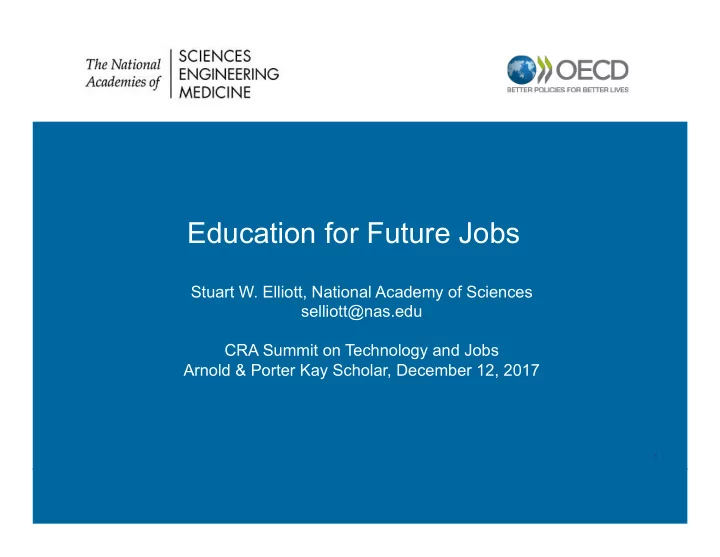

Education for Future Jobs? Stuart W. Elliott, National Academy of Sciences selliott@nas.edu CRA Summit on Technology and Jobs Arnold & Porter Kay Scholar, December 12, 2017 1 1
Linking job impact of AI to education • Shift focus away from jobs to skills What transition is required? o Is it feasible? o • Evaluate AI using standardized tests Uses explicit tasks, not vague topics o Allows direct comparison with people o Contrast to Oxford, McKinsey analyses o 2
Example: OECD’s Survey of Adult Skills (PIAAC) • PIAAC measures 3 widely-used work skills Literacy, numeracy, problem solving with computers o 75% OECD workers use these skills every day o Huge investment in education to develop them o 3
Example PIAAC Literacy Questions Level 3 • International calls Text: website describing how to make international calls o Question: When would you need to dial 098? o Instruction: Highlight information to answer the question o Level 4 • Library search Text: results of library search with titles and brief o descriptions of books about genetically modified foods Question: What book suggests that the claims for and o against genetically modified foods are both unreliable? 4
PIAAC Literacy: OECD Adults vs. AI ¡ ¡ ¡ Proficiency ¡Level ¡ OECD ¡Adults ¡ AI ¡ 2 ¡and ¡below ¡ 53% ¡ 3 ¡ 35% ¡ 4-‑5 ¡ 11% ¡ 5
PIAAC Literacy: OECD Adults vs. AI ¡ ¡ ¡ Proficiency ¡Level ¡ OECD ¡Adults ¡ AI ¡ 2 ¡and ¡below ¡ 53% ¡ Yes ¡ 3 ¡ 35% ¡ Close ¡ 4-‑5 ¡ 11% ¡ No ¡ Source: Elliott, 2017, Computers and the Future of Skill Demand , OECD 6
Simple model of skill adjustment • Cognitive skills – developed in education • Physical skills – developed outside of education Physical ¡Skills ¡ Cogni=ve ¡ ¡ ¡ ¡ Skills ¡ Low ¡ Medium ¡ High ¡ Low ¡ Medium ¡ High ¡ 7
Simple model of skill adjustment Distribution of Current US Employment by Cognitive and Physical Skills (using O*NET) Physical ¡Skills ¡ Cogni=ve ¡ ¡ ¡ ¡ Skills ¡ Low ¡ Medium ¡ High ¡ Low ¡ 0% ¡ 0% ¡ 0% ¡ Medium ¡ 7% ¡ 74% ¡ 1% ¡ High ¡ 1% ¡ 17% ¡ 0% ¡ Source: Elliott, 2014, Anticipating a Luddite Revival, Issues in Science and Technology, XXX(3):27-36. 8
Simple model of skill adjustment Use computers as cognitive assistants Physical ¡Skills ¡ Cogni=ve ¡ ¡ ¡ ¡ Skills ¡ Low ¡ Medium ¡ High ¡ Low ¡ 7% ¡ 74% ¡ 1% ¡ Medium ¡ High ¡ 1% ¡ 17% ¡ 0% ¡ 9
Simple model of skill adjustment But the physical skills may develop at the same time Physical ¡Skills ¡ Cogni=ve ¡ ¡ ¡ ¡ Skills ¡ Low ¡ Medium ¡ High ¡ Low ¡ 7% ¡ 74% ¡ 1% ¡ Medium ¡ High ¡ 1% ¡ 17% ¡ 0% ¡ 10
Simple model of skill adjustment Also use computers as physical assistants Physical ¡Skills ¡ Cogni=ve ¡ ¡ ¡ ¡ Skills ¡ Low ¡ Medium ¡ High ¡ Low ¡ 81% ¡ 1% ¡ Medium ¡ High ¡ 18% ¡ 0% ¡ 11
Simple model of skill adjustment Potential large-scale automation Physical ¡Skills ¡ Cogni=ve ¡ ¡ ¡ ¡ Skills ¡ Low ¡ Medium ¡ High ¡ Low ¡ 81% ¡ 1% ¡ Medium ¡ High ¡ 18% ¡ 0% ¡ 12
Simple model of skill adjustment But we don’t expect massive unemployment Physical ¡Skills ¡ Cogni=ve ¡ ¡ ¡ ¡ Skills ¡ Low ¡ Medium ¡ High ¡ Low ¡ 1% ¡ Medium ¡ High ¡ 18% ¡ 0% ¡ 13
Simple model of skill adjustment Instead: long-term expansion of remaining jobs Physical ¡Skills ¡ Cogni=ve ¡ ¡ ¡ ¡ Skills ¡ Low ¡ Medium ¡ High ¡ Low ¡ 5% ¡ Medium ¡ High ¡ 95% ¡ 0% ¡ 14
Simple model of skill adjustment • Scenario 1: cognitive automation but not physical Need less education o • Scenario 2: both cognitive and physical automation Need much more education o • Conclusion: more education not necessarily the right response It depends on what happens with skills developed o outside of education 15
Improving Skills: PIAAC Literacy Level 4-5 • We can do better than the OECD average of 11% Adults with higher education: 21% o Adults in Japan with higher education: 37% o • But improvements are hard Decreased 2 percentage points since 1990s o • No examples at scale with most adults at Level 4-5 16
We need more information • What we don’t know Do we need more or less education? o Can we move many more people to higher skills? o • Proposed OECD-National Academies program Assess capabilities of AI and robotics in all work skills o Compare to human skills and education potential o 17
Contact: Stuart W. Elliott selliott@nas.edu 18
Recommend
More recommend